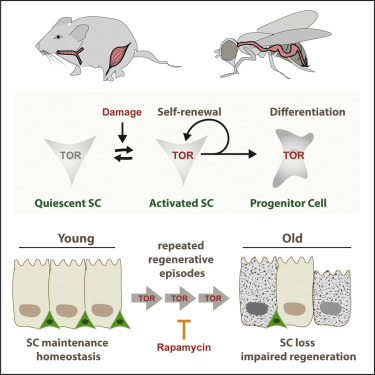当前位置:
X-MOL 学术
›
Cell Stem Cell
›
论文详情
Our official English website, www.x-mol.net, welcomes your
feedback! (Note: you will need to create a separate account there.)
mTORC1 Activation during Repeated Regeneration Impairs Somatic Stem Cell Maintenance.
Cell Stem Cell ( IF 19.8 ) Pub Date : 2017-Dec-07 , DOI: 10.1016/j.stem.2017.11.008 Samantha Haller , Subir Kapuria , Rebeccah R. Riley , Monique N. O’Leary , Katherine H. Schreiber , Julie K. Andersen , Simon Melov , Jianwen Que , Thomas A. Rando , Jason Rock , Brian K. Kennedy , Joseph T. Rodgers , Heinrich Jasper
Cell Stem Cell ( IF 19.8 ) Pub Date : 2017-Dec-07 , DOI: 10.1016/j.stem.2017.11.008 Samantha Haller , Subir Kapuria , Rebeccah R. Riley , Monique N. O’Leary , Katherine H. Schreiber , Julie K. Andersen , Simon Melov , Jianwen Que , Thomas A. Rando , Jason Rock , Brian K. Kennedy , Joseph T. Rodgers , Heinrich Jasper

|
The balance between self-renewal and differentiation ensures long-term maintenance of stem cell (SC) pools in regenerating epithelial tissues. This balance is challenged during periods of high regenerative pressure and is often compromised in aged animals. Here, we show that target of rapamycin (TOR) signaling is a key regulator of SC loss during repeated regenerative episodes. In response to regenerative stimuli, SCs in the intestinal epithelium of the fly and in the tracheal epithelium of mice exhibit transient activation of TOR signaling. Although this activation is required for SCs to rapidly proliferate in response to damage, repeated rounds of damage lead to SC loss. Consistently, age-related SC loss in the mouse trachea and in muscle can be prevented by pharmacologic or genetic inhibition, respectively, of mammalian target of rapamycin complex 1 (mTORC1) signaling. These findings highlight an evolutionarily conserved role of TOR signaling in SC function and identify repeated rounds of mTORC1 activation as a driver of age-related SC decline.
中文翻译:

重复再生过程中的mTORC1激活会损害体干细胞的维持。
自我更新和分化之间的平衡可确保再生上皮组织中干细胞(SC)库的长期维护。在高再生压力期间,这种平衡受到挑战,并且在成年动物中经常受到损害。在这里,我们表明雷帕霉素(TOR)信号的目标是反复再生发作期间SC丢失的关键调节器。响应于再生刺激,小鼠的苍蝇的肠上皮和气管上皮中的SCs显示出TOR信号转导的瞬时激活。尽管需要激活才能使SC迅速响应损伤而增殖,但反复损伤会导致SC丢失。一致地,可以分别通过药理或基因抑制作用来预防小鼠气管和肌肉中与年龄相关的SC丢失,雷帕霉素复合物1(mTORC1)信号转导的哺乳动物靶标的表达。这些发现强调了TOR信号在SC功能中的进化保守作用,并确定了mTORC1激活的重复循环是与年龄相关的SC下降的驱动力。
更新日期:2017-12-07
中文翻译:

重复再生过程中的mTORC1激活会损害体干细胞的维持。
自我更新和分化之间的平衡可确保再生上皮组织中干细胞(SC)库的长期维护。在高再生压力期间,这种平衡受到挑战,并且在成年动物中经常受到损害。在这里,我们表明雷帕霉素(TOR)信号的目标是反复再生发作期间SC丢失的关键调节器。响应于再生刺激,小鼠的苍蝇的肠上皮和气管上皮中的SCs显示出TOR信号转导的瞬时激活。尽管需要激活才能使SC迅速响应损伤而增殖,但反复损伤会导致SC丢失。一致地,可以分别通过药理或基因抑制作用来预防小鼠气管和肌肉中与年龄相关的SC丢失,雷帕霉素复合物1(mTORC1)信号转导的哺乳动物靶标的表达。这些发现强调了TOR信号在SC功能中的进化保守作用,并确定了mTORC1激活的重复循环是与年龄相关的SC下降的驱动力。











































 京公网安备 11010802027423号
京公网安备 11010802027423号